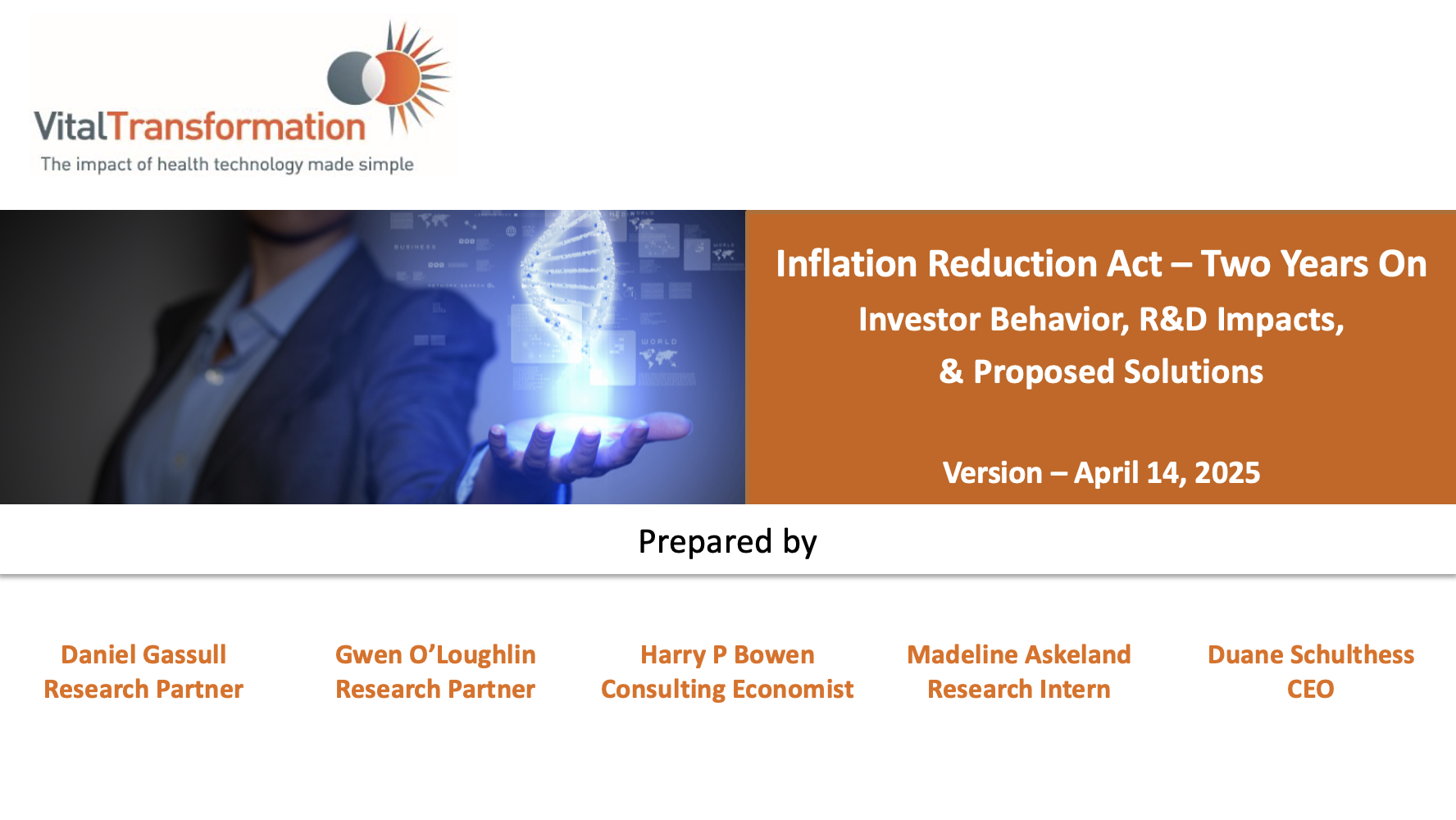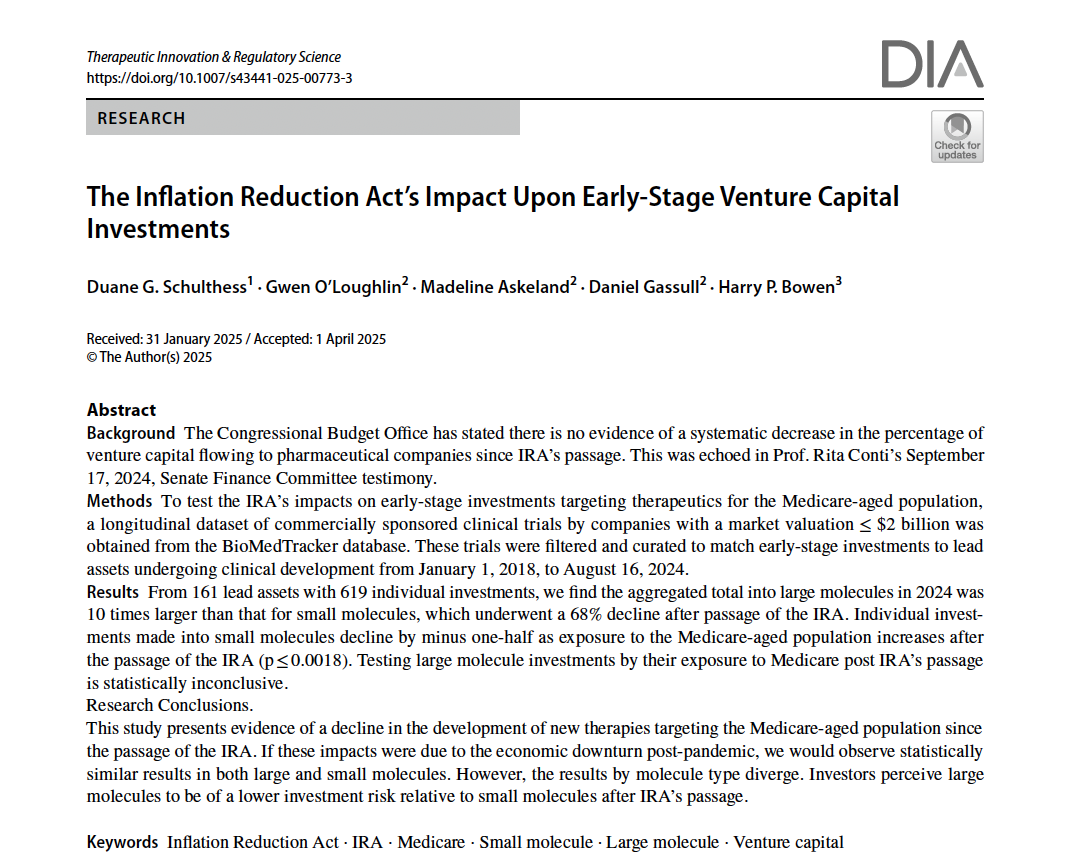Inflation Reduction Act – Two Years On
Investor Behavior, R&D Impacts, & Proposed Solutions
The Executive Summary
IRA has led to:
- A 35% reduction in early-stage phase I and II therapies under development from 2021-2023 among small and midsize biotech companies as measured from IRA’s introduction; the average time of phase II and III development is roughly 40 months each, we would expect to see a considerable reduction in the number of FDA approvals in roughly 5 to 6 years.
- A statistically significant reduction in the size of VC investments for small molecules with a high exposure to the Medicare-aged population, which is exposure above the mean at % above age 65, after the introduction of the IRA and no corresponding reduction in the size of VC investments for small molecules with a Medicare exposure below the mean.
- A statistically significant reduction of > 70% in the median size of VC investments for small molecules treating indications with a high exposure to the Medicare-aged population in our cohort – these include Disease Dementia, Non-Small Cell Lung Cancer, Prostate Cancer, Multiple Myeloma and others.We also see a shift in the number of clinical trials from small to large molecules in areas with a high exposure to the Medicare-aged population, such as neurology and autoimmune disease classes.
When indications have exposure to the IRA’s impacts, we observe divergent results between large and small molecules; this presents statistically significant evidence of specific disincentives caused by the legislation for the Medicare-aged population.
Removing the ‘pill penalty’ by beginning IRA price setting for both small and large molecules after 13 years increases approvals targeting the Medicare-aged population by 20%.
Beginning IRA price setting after 15 years is estimated to reduce the number of medicines lost to the Medicare-aged population 50%.
Conclusions and implications
Despite IRA’s maximum fair prices not being in place for another year, the IRA’s introduction has led to:
- A 35% reduction in early-stage phase I and II therapies under development by small and midsize biotech companies. As such, we would expect to see a corresponding reduction in the number of FDA approvals in roughly 5 to 6 years.
- A statistically significant shift away from the development of therapies treating indications with a high exposure to Medicare-aged populations including Alzheimer’s Disease (AD), Non-Small Cell Lung Cancer (NSCLC), Head and Neck Cancer, Stroke, Renal Cell Cancer (RCC), Bladder Cancer, Cerebral Edema, and others. We also see a shift in the number of clinical trials from small to large molecules in areas with a high exposure to the Medicare-aged population in classes such as Neurology and autoimmune diseases
- A statistically significant shift in developments of small molecules away from therapies targeting indications with a high exposure to the Medicare-aged population, with evidence that large molecules are seen as having less risk for early-stage investors.
- A decline in the overall size of early-stage investments; this is indicative of VCs and angels altering their estimates of future rates of return. Our research provides evidence that this is at least partly due to exposure of specific assets to the impacts of the IRA.
Removing the ‘pill penalty’ and beginning IRA price setting at 13 years for both small and large molecules, our modeling finds a 20% increase in the number of therapies developed that target the Medicare-Aged population.
By increasing the time of IRA MFPs to 15 years, we see an improvement by 50% of the medicines available in Medicare.
Methodology
- VT extracted a cohort of 1137 clinical trials from the period of January 1, 2018, through May 6, 2024, of US companies with a market capitalization or valuation of less than $2 billion USD as it is a standard forward looking risk-weighted net present value of a successful firm at the time of a therapeutic product’s FDA submission for marketing authorization.
- VT then engaged in a company by company search in Biomedtracker and clinicaltrials.gov, to determine which of these development programs had a therapy showing potential for success. This research yielded 228 ‘lead assets’, segmented by indication and clinical trial phase.
- These developments were further filtered to focus on only those lead assets in Phase I and II clinical trials, yielding 161 early-stage therapies.
- VT executed a forensic audit of all investment activity that could be identified for each lead asset from the period of January 1st, 2018, through August 16th, 2024, using the combined resources of Pitchbook, Biomedtracker, Securities and Exchange Commission audited Federal filings, and published annual corporate reports.
- IRA’s investments and R&D impacts have been calculated in July 2024 constant dollars with a cost of capital of 10%.
- Our investment criteria is focused on revenue generated from VC, angel, equity, partnering and licensing activity – debt assumed by the developing company has been excluded. Where a clear audit trail of investment or ownership was not possible, those companies and developments have been excluded from our analysis.
- The focus of this analysis is Type-1 novel FDA approved therapies; follow-on indications or post-approved combination therapies have been excluded from this analysis.





